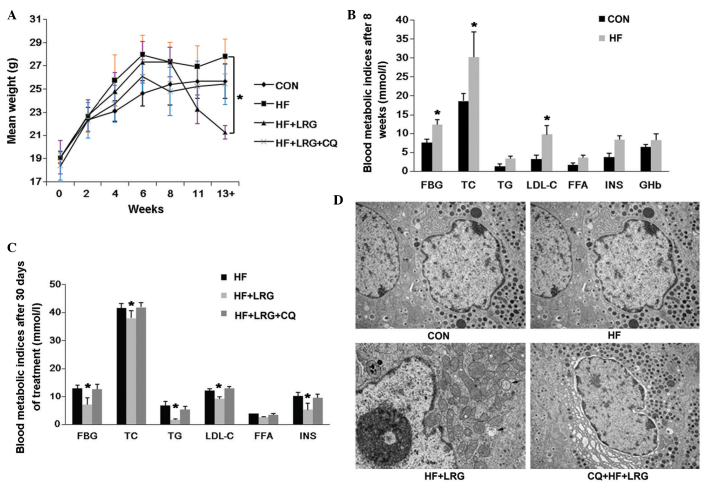Figure 5.
LRG reduces the body weight and improves glucolipid metabolism of the mice, and these effects are reversed by the inhibition of autophagy. (A) Body weights of mice in the normal diet fed group (CON), mice fed with a high-fat diet for 8 weeks and injected with streptozotocin (HF), mice fed a high-fat and treated with intraperitoneal injection of LRG (1 mg/kg, twice/day) for 30 days (HF + LRG) and mice fed with a high-fat and treated with intraperitoneal injection of LRG (1 mg/kg, twice/day) and CQ (50 mg/ml, once/3 days) for 30 days (HF + LRG + CQ). (B) Blood metabolic indices of mice in the CON and HF groups after 8 weeks of a normal or high-fat diet. (C) Blood metabolic indices of mice in HF, HF + LRG and CQ + HF + LRG groups after 30 days treatment with either normal saline, LRG or LRG + CQ. (D) Electron microscopy images of pancreatic tissues of mice in the CON, HF, HF + LRG and CQ + HF + LRG groups. Arrows indicates autophagosomes (magnification, ×8,000). All data are expressed as the mean ± standard deviation. LRG, liraglutide; CON, control; HF, high-fat; CQ, chloroquine; FBG, fasting blood glucose; TC, total cholesterol; TG, plasma triglyceride; LDL-C, low density lipoprotein cholesterol; FFA, free fatty acids; INS, fasting insulin; GHb, glycated hemoglobin.

